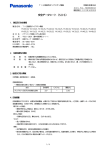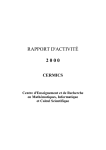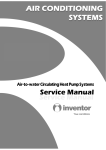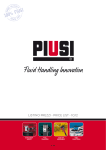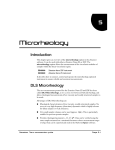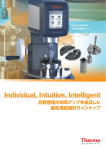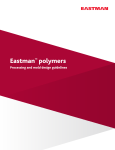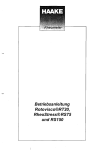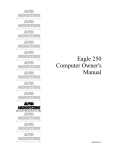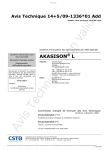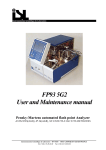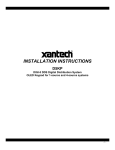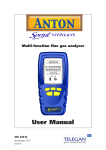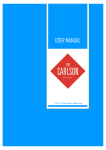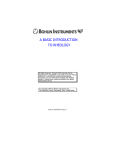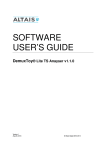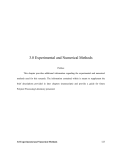Download New Product Brochure
Transcript
• News & Views Expanded contract testing capabilities all industries Rheology Solutions has purchased the newest HAAKE MARS III Rheometer to be housed in our applications laboratory in Bacchus Marsh, Victoria. The new HAAKE MARS III Rheometer will extend our capabilities in product testing and system demonstration, and for progressing the commercialisation of our Online Rheometer (OLR). The HAAKE MARS III is a high-end, modular, controlled stress rheometer. Rheology Solutions have also invested in the High Temperature (60ºC-400ºC) and RheoScope modules extending the HAAKE MARS III's capabilities even further. Our laboratory includes a broad range of concentric cylinder, cone/plate and plate/plate sensor systems which allow us to test very highand very low-viscosity liquids, suspensions, emulsions and solutions, also a vapour trap to minimise losses at elevated temperatures or where solvents etc. are involved. The High Temperature module will allow controlled temperature (constant or ramped) testing of materials from food, pharmaceutical and cosmetics through to polymer melts, and anything in-between. The RheoScope module combines the advantages of a microscope and a rheometer, allowing us to capture short movies or individual images of the test material in the measurement gap, as well as individual images. Each image is coupled with a data-point, to allow the user to relate rheological information to an image of the material under the specific flow conditions in the measurement gap at that instant. This allows rheological phenomena to be more readily explained, in particular unusual or transitional/transient behaviour. The RheoScope module has high temperature capability, allowing testing up to 300ºC. Expanded capabilities polymer Industries Our contract testing customers in the polymer industry, can now expect polymer melt testing and visualisation up to 300ºC (with the RheoScope module), and standard melt testing up to 400ºC (with the High Temperature module). Expanded capabilities - food, pharma, coatings & mining For food, pharma, coatings and mining customers, we now have the capability of testing and diagnosing flow stratification, rheodestruction etc. at high shear rates, especially in cases where a micron-scale structure is present, which can be observed using the RheoScope module. In a similar way, structural build-up (e.g. flocculation, aggregation, cross-linking) at low and moderate shear can be monitored and investigated rheologically and microscopically (in the micron size range). Contract testing services Contract testing services specifically for industrial applications is available. A range of comprehensive data can be provided for: • Liquid properties. • Creep & recovery tests. • Viscoelastic moduli. • Flow curves. • Yield stress. • Viscosity curves. • Extensional properties including: - Apparent extensional viscosity. - Time to break-up of strands. - Extensional constants. • Concentration and temperature profiles. • Effects of particle size distribution. • Effects of additives and viscosity modifiers. • QA/QC for optimal processing. These tests will provide valuable information for process design, modification and control. Test results can be provided simply as data files or supplied with complete interpretation and recommendations. dec 10-mar 11 Rheology Solutions can facilitate testing at our overseas suppliers laboratories when required. Instruments & equipment in the applications laboratory The Rheology Solutions applications laboratory is equipped with a comprehensive range of equipment and instruments to meet the requirements of material characterisation. This combination of instruments and equipment allows the testing and definition of the material properties of most solids and liquids. In this way Rheology Solutions can provide unparalleled expertise and customer advice for sensible instrument and sensor selection as well as consultation and test procedure development.• Thermo Scientific HAAKE MARS III with RheoScope Module Contract testing at high temperature will be available from February 2011. Enquiries? Send an email to [email protected] with full details. [email protected] 1 www.rheologysolutions.com • in this issue: Technical Papers 09 Article: Standard Search for Specks 09 Oscillatory Squeeze Flow for Process Rheometry 08 Accurate Temperature Control for the Separation of Solvents from Liquid Samples 10 Filter Pressure Value Test 10 Understanding Temperature Control in Bioreactor Systems 10 What Happens When Rheological Properties Change? News & Views 05 K Show Overview 08 Commercialisation Australia Funding Announcement 04 2011 Exhibitions 07 Service & Calibration Program 01 Expanded Contract Testing Capabilities Product News & Industry Applications 03 06 02 14 16 15 13 12 11 13 11 12 Rotational Viscometers Laboratory Chiller New - Rheology & FT-IR Module Temperature Control Baths Film Surface Analyser New Product - Rheometer for Mortar and Fresh Concrete New - Peltier Temperature Control Unit New Literature Best Quality Control for the Petrochemical Industry Comprehensive Material Characterisation for Polymers - updated Modular Rheometer Platform - updated Process Control Rheometers - updated Thermo Scientific Viscometer 2 dec 10-mar 11 • Product News Simultaneous rheological and FT-IR spectra measurements all industries The Thermo Scientific HAAKE MARS III has a number of application solutions within its suite of models and now this has been expanded to include simultaneous rheological and FT-IR spectra measurements. Discover simultaneous rheometry and FT-IR spectroscopy with the unique HAAKE MARS III Rheonaut technology. The module offers: • Simultaneous rheology and FT-IR spectroscopy • Rheonaut as compact module for HAAKE MARS III rheometer • ATR (attenuated total reflection) principle • Analysis of structural changes under shear / deformation • Extensive investigation of thermal / UV curing reactions Temperature range Standard version 0°C - +120°C (Peltier temperature control unit) High temperature option ambient - +400°C (electrical temperature control unit) Measuring geometries Plates and cones with diameters up to 60 mm The HAAKE MARS III offers: • Reliable and accurate rheological measurements • Modular rheometer solutions to suit individual application requirements in different industries 00W through to 10,000W cooling capacities.• Specifications of the Rheonaut module Spectrometer • compatible with several standard IR spectrometers (side port required) Measuring principle • ATR using single reflection crystal (diamond) • DTGS (deuterated triglycine sulfate) detector Data acquisition and storage HAAKE RheoWin software with integrated control of the FT-IR spectrometer (for selected spectrometer models), automatic synchronisation of rheological data and FT-IR spectrum data. • In This Issue Specific Industry Key all industries Pg. 1, 2, 3, 6, 7, 8, 9, 12, 13, 14 construction & Pg.15 building industries polymer industries Pg. 4, 5, 8, 9, 10, 11, 12, 13, 16 surface coatings industries Pg. 8, 10 food industries Pg. 9, 10, 16 pharma, cosmetic Pg. 8, 9, & allied industries 10, 16 mining industries Pg. 4 chemical & allied industries Pg. 8, 10, 16 www.rheologysolutions.com • Product News Rotational viscometers - to suit those seeking convenience up to the expert model measurements all industries Application The Thermo Scientific HAAKE Viscotester E, D and C units can be used for tests and comparative measurements for quality control according to recognized standards. Measuring principle The HAAKE Viscotester E, D and C are classical rotational viscometers that measure the resistance of a test substance against a preset speed. The resulting torque or resistance measures the viscosity of the fluid. The higher the torque, the higher the viscosity. Due to the type of standardised geometries, the shear rates generated can only be determined precisely for Newtonian substances. Compatibility The basic ISO 2555 standard describes the design and the characteristic measuring technique of a viscosity measuring instrument (torque, speed, rotor geometry). If rotational viscometers meet these requirements, results comply. Common features of the HAAKE Viscotester E, D and C • Ready to go package - unpack, switch on and start measuring viscosity • Digital display of viscosity, % torque, speed, spindle, upper viscosity limit, temperature (optional), in selectable units • Integrated automatic diagnostic functionality • Visual and acoustic signals at critical measuring conditions • Easy viscosity and temperature (optional) calibrations • 10 user interface languages Standards The HAAKE Viscotester E, D and C meet the following standards: BS: 6075, 5350; ISO: 2555, 1652 ASTM: 115, 789, 1076, 1084, 1286, 1417, 1439, 1638, 1824, 2196, 2336, 2364, 2393, 2556, 2669, 2849, 2983, 2994, 3232, 3236, 3716 Technical data • Viscosity range: depending on version (L or R) • Accuracy: +/- 1% FSD • Reproducibility: 0.2% • Supplied at 100 - 240V/50 - 60 Hz • HAAKE Viscotester E The expert model For automatic flow curve measurements with full PC control. Additional features: • 6 line LCD display with 12 keys • Display of sample temperature, shear rate and shear stress for coaxial spindles, routine parameters, etc. • Internal memory for 9 advanced measuring routines • Routine programming functions • USB for software control • Rotational speeds: 54 between 0.01 rpm and 200 rpm • Viscosity range: R-Version: 100 mPas – 40.000.000 mPas L-Version: 15 mPas – 6.000.000 mPas Optional: • One hand quick fit coupling for spindles • HAAKE RheoWin measuring and evaluation software HAAKE Viscotester D The distinct model For routine viscosity measurements with data transfer. Additional features: • 6 line LCD display with 6 keys • Internal memory for 9 basic measuring routines • USB interface for data transfer to PC • Rotational speeds: 21 between 0.1 rpm and 200 rpm • Viscosity range: R-Version: 100 mPas – 13.000.000 mPas L-Version: 15 mPas – 2.000.000 mPas Optional: • Temperature sensor Pt 100 • Display of sample temperature • One hand quick fit coupling for spindles • HAAKE RheoWin data evaluation software HAAKE Viscotester C The convenient model For easy, fast and accurate manual viscosity measurements. Additional features: • Simple and intuitive operation • 4 line LCD display with 6 keys • Rotational speeds: 21 between 0.1 rpm and 200 rpm • Viscosity range: R-Version: 100 mPas – 13.000.000 mPas L-Version: 15 mPas – 2.000.000 mPas 3 [email protected] dec 10-mar 11 • News & Views 2011 Exhibition program During 2011, Rheology Solutions are participating in the following major industry exhibitions and conferences: polymer industries 13 - 17 February 2011 32 Australasian Polymer Symposium Coffs Harbour, NSW Visit Rheology Solutions on Stand no: 1 Products on display: HAAKE MARS III - Fully operational with RheoScope Module www.32saps.org.au The Australasian Polymer Symposium is a feast of polymer science covering all topics ranging from polymer synthesis, characterisation, physics of polymers, engineering to materials. Topics will span from fundamental polymer science such as modelling to applied materials. A considerable portion of the APS is always dedicated to the interface of polymer science with other disciplines such as biomaterials, nanomaterials and surface science. Paper from the Online Rheometer (OLR) Group, Rheology Solutions or reliable diagnosis of process problems. There is a clear need for more comprehensive on-line measurements for process control. On-line rheometry for industrial process and quality control T.J. Kealy, P.K. Bhattacharjee Oscillatory Squeeze Flow (OSF) has been discussed and proposed as a viable QA/QC alternative for dynamic oscillatory shear flow measurements in the laboratory. In recent times, some commercially available OSF laboratory rheometers have arrived on the market (notably the prototype C-20 previously available from TA instruments until around 2003/2004, and the MFR 2100, currently available from GBC Scientific). So far an on-line variant of these instruments has not been available. Combining OSF techniques with Fast Fourier Transforms (FFTs) can facilitate rapid turn-around of measurements, faster than is possible for the traditional laboratory measurements in shear flow. This combination has facilitated the development of an Online Rheometer (OLR) based on OSF techniques for near-continuous measurement of characteristic dynamic flow curves in-the-pipe. Traditional industrial process control and Quality Assurance/Quality Control (QA/QC) by rheological measurements for polymeric materials has mostly been limited to capillary-type measurements for polymer melts. Forced flow of the melt at various velocities through single- or twin-bore capillaries of known geometry is used to generate a flow curve for the polymer as it is processed through an extrusion system. These measurements provide the interested engineer with a measure of the polymer flow properties over a relatively wide range of shear rates. The flow properties usually take the form of either a steady shear flow curve, relating the shear viscosity of the material to shear rate, or the Melt Flow Index (MFI). The Online Rheometer (OLR) Group will present a paper at 32APS, in Coffs Harbour, NSW. This paper will introduce to the dilute polymer and biopolymer communities the OLR concept, by comparing the OLR with traditional measurement technologies for process control and quality assurance. The contrasting of the measurements made by traditional on-line and laboratory rheological measurement techniques with those of the OLR will be presented. The data will be collected using our newly commissioned pipe-loop facility and a high-end laboratory rheometer, the HAAKE MARS III. In contrast with these measurements the common techniques for dilute polymer systems, such as high molecular weight polysaccharides typically used for the texturisation of surface coatings, food or cosmaceuticals (hand soap, shampoo, body crème etc.) usually have only a single point pseudo-viscosity measurement in-the-pipe. The measurements are most often based on a torsional principle, whereby the vibration of a probe is damped by the viscous fluid around it. The damping effect of the fluid is related to the viscosity. These techniques are widely used, but the results from these techniques are often difficult to directly compare with those obtained in laboratory instruments. In fact, they most often offer a single-point pseudo-viscosity, which is often insufficient for good process control, QA/QC, This paper presents the contrasting data available from traditional on-line rheological techniques (pressure-drop measurements, and two different torsional damping technologies) with the new OLR technique. The measurements were made for typical process conditions, at a pipe-loop facility using well characterised aqueous long-chain polysaccharide solutions as the test material, and the data from all of the techniques are contrasted with steady shear and dynamic data from a laboratory rheometer. We show that the OLR technique compares well with dynamic data from the laboratory rheometer, and that it has significant process-related advantages over traditional torsional techniques for process control and QA/QC. mining industries Keep a watch out for the HAAKE VT550 purchase offer that is only available to those that attend the conference and visit us on Stand no: 8. will also address the important part that P&TT plays in incremental rehabilitation and its impact on mine closure goals. www.paste2011.com The organisers expect state-of-the-art and innovative papers from leading experts and top practitioners throughout the world. These will be presented during one of the most dynamic events on paste and thickened tailings to be held in Australia. 4 - 8 April 2011 Paste 2011 Fremantle, Western Australia Visit Rheology Solutions on Stand no: 8 Products on display: HAAKE Viscotester VT550 4 dec 10-mar 11 Paste 2011 will explore the latest advances in the preparation, transportation and deposition of paste and thickened tailings (P&TT) that will be reinforced by current case studies. This seminar www.rheologysolutions.com polymer industries 24 - 27 May 2011 Ausplas 2011 Melbourne, Victoria Visit Rheology Solutions on Stand no: 844 We will have 18m2 to showcase the latest and newest products from Thermo Scientific and Optical Control Systems (OSC). The instruments from OCS will be operational and we will be offering sample testing. Further information will be provided closer to the exhibition. If you are interested in having optical scanning conducted on your sample or product, contact us to discuss your requirements. www.ausplas.com Ausplas is Australia's national trade exhibition for the plastics processing industry. It has been held every three years since the early 80's, with the last event having taken place in October 2008. In a significant new development, Ausplas will co-locate with two other major manufacturing industry trade exhibitions, Austech and National Manufacturing Week.• • News & Views K show overview - Dusseldorf, Germany polymer industries For more than 40 years, K has been and still is the biggest international trade fair for plastics and rubber, and takes place once every three years. The leading raw material producers, processing companies and machinery manufacturers offer an overview of the latest technical developments, procedures and techniques, of current construction methods and future trends. The plastics industry is one of the most innovative segments of the world economy and plastics are seen as the material of the 21st century. Major advances in products and processes - plastics are key. In 2007, Rheology Solutions visited the K Show and spent time on both the exhibition stands of Thermo Scientific and Optical Control Systems (OCS). This year, we did not attend as one of the nearly 250,000 visitors. We are pleased to provide you with an overview of what was on their stands. • • At the K Show this year, Thermo Scientific were in hall 10, Stand B59 and showcased an extensive range of products specific to the polymer industry. This included: • • Injection moulding machine that offers efficient sample preparation - Thermo Scientific HAAKE MiniJet Measuring mixers and extruders that allow the user to gain insight into their processes Thermo Scientific HAAKE PolyLab OS. From sample batches of 50 grams up to outputs of 10 kg/h, the bench mounted 16 mm Thermo Scientific EuroLab XL twin-screw extruder is the complete compounding and sample preparation system Rheometers and viscometers that offer a comprehensive application solution specific for industry applications - Thermo Scientific HAAKE MARS III and HAAKE RheoStress 6000 Micro-compounding with a micro-conical twin-screw compounder for compounding and processing of small sample volumes Thermo Scientific HAAKE MiniLab Optical Control Systems (OCS) were in hall 10, Stand E21 and this year their exhibition highlights were: • Newly developed PS400C - pellet scanning system for defect detection (50/100ºm) and sorting in normal production up to 800 kg/hr including mixing ratio determination and specially suited for super-transparent granules • Three extrusion lines (cast, blown and calendar/tape test line) with several control systems: APLAIRS® (FT-IR Spectrometer), Film Scanning Systems, Thickness - Gloss and Haze measurements • Process Melt Rheometer - OP5 • Pellet Anayser - PA66 • Pellet Transport System - PTS • 5 [email protected] dec 10-mar 11 • Product News New laboratory chiller all industries Heat and cool external applications with a temperature range of -10°C to +80°C and either a 250W or 500W cooling capacity. The Thermo Scientific Polar Series of chillers are a versatile and economical option for laboratory cooling and heating needs. Its bathless design minimises the evaporation of temperature fluid during daily use. Applications • Analytical equipment • Chromatography • Electrophoresis • Laser diode cooling • Various research applications • Specifications Accel 250LC Accel 500LC 50Hz at 20ºC 2 kW 2 kW Cooling Capacity at 20ºC 250 Watts 500 Watts Working Temperature Range -10ºC to 80ºC -10ºC to 80ºC Temp Stability +/- 0.1ºC +/- 0.1ºC Heating Capacity Force Pump Maximum Flow 17 lpm 17 lpm Maximum Pressure 300 mbar (4.4 psi) 300 mbar (4.4 psi) 21 lpm 21 lpm Force/Suction Pump Maximum Flow Maximum Pressure 805 mbar (11.7 psi) 805 mbar (11.7 psi) Reservoir Volume 2.8 litres 2.8 litres Unit Weight 30 kg 30 kg 62 x 23.2 x 48.7 62 x 23.2 x 48.7 Physical Dimensions (HxWxD) Centimeters (cm) Voltage Options 220-230V/50Hz Available Available Compliance UL/RoHS UL/RoHS Features & Benefits Feature Benefit Small foot-print 62 x 23.2 x 48.7cm Internal Reservoir Reduces evaporation concerns of open bath design Easy to use, fluid fill, drain & site tube line Fill the unit, drain the unit, and view the fluid level with the same tube line Full range cooling feature Limits power consumption for efficient operation Pump speed control Allows the user to set the pump speed at either 50% or 100% for tighter control Energy Savings Feature Limits power consumption for efficient operation Multi Lanhuage HMI Offers the option of English, French or German on the display USB Port/RS232 Communication (otional) Provides digital communication for remote operation and monitoring The Polar Series Laboratory Chiller is ideal to control temperatures within a variety of laboratories within the following industries: Pharmaceutical, Biotechnology, Academic Research, Food and Beverage, Chemical and Petrochemical. 6 dec 10-mar 11 www.rheologysolutions.com • News & Views - Service and calibration program 2010 - 2011 Viscometers and rheometers - why check calibration? all industries The accuracy of the electronic components used in all instruments drifts over time. The effects of time in service as well as environmental conditions add to this drift. As time progresses changes in component values cause greater uncertainty in your measurements. At some point in time, the drift causes the instruments uncertainty to become undefined, meaning the manufacturer can no longer predict the uncertainty and guarantee measurement results. To resolve this issue instruments must be calibrated at regular intervals as defined by the manufacturer. A calibration check is the comparison of an instruments performance to a standard of known accuracy. The result of a calibration check may be documentation showing the deviation of a measurement from the known standard or it may also include adjusting the instruments measurement capability to improve accuracy (re-calibration). The goal of a calibration check is to quantify and improve the measurement accuracy of your instrument. The benefits of maintaining properly calibrated equipment include: • Reduced measurement errors • Consistency between measurements • Increases in production yields • Assurance you are making accurate measurements Rheology Solutions recommends that you periodically calibrate your hardware to ensure measurement accuracy and to keep your instrument operation in peak precision. Calibrations To minimise the cost to our customers, we conduct scheduled annual calibrations interstate, however if you wish your rheometer or viscometer calibrated outside of the set program, please phone or email our Administration Manager, Jackie at [email protected] and she will either organise your HAAKE equipment to be sent to our office or put you on the list for a site visit to coincide with the schedule. All equipment received for calibration will have a 48 hours turnaround from the time it arrives in our office. We will contact you to confirm receipt of equipment and date for return despatch. Calibration letters have been sent out to those customers that have previously had their HAAKE equipment calibrated by us. We will be in contact in the coming weeks to arrange and finalise your booking. If you have not received a calibration letter from us and require your instrument calibrated, please contact our office to arrange your booking. Interstate calibration schedule • Queensland Week commencing 10th January 2011 • New South Wales Week commencing 7th February 2011 • South Australia Week commencing 7th March 2011 • Western Australia Planned Mid November 2011 • Tasmania Please contact our office to arrange a time The pricing for calibrations that are conducted in our office or link in with the scheduled interstate schedule in 2010/2011 are based on Melbourne Metropolitan rates as follows: HAAKE MARS $ 1,650.00 HAAKE RheoScope 1 $ 1,650.00 HAAKE RheoStress 6000 $ 1,650.00 HAAKE RheoStress 1 $ 1,650.00 HAAKE RotoVisco 1 $ 1,250.00 HAAKE ViscoTester 550 $ 825.00 Notes: • Melbourne metropolitan customers can have their HAAKE instrument calibrated at any time on site. • Victorian customers (non metropolitan) can arrange for calibration of their instrument at any time or when the next scheduled calibration is due by contacting our office direct. • Prices exclude GST, and any parts required for instrument repairs. • Multiple unit calibrations are priced on a sliding scale if they are serviced at the same time. Prices are available on request. All calibrations are completed by our Service Engineer who is factory trained at the manufacturers. A calibration certificate is provided as verification. As part of the calibration our Service Engineer will • check and adjust the high sensitive measuring head to plate geometry • calibrate all physical measurement parameters according to standards • maintain all moveable parts • ensure your rheometer is in its optimal condition If any parts are required in order to repair any instrument found to be faulty, these will be ordered directly from our suppliers, which can take four - six weeks to arrive. When the parts are on hand the repair can be finalised. We will notify you of timing and request that you please be patient if this is the case.• Quotes for all repairs and spare parts can be obtained from us at any time. 7 [email protected] dec 10-mar 11 • News & Views Commercialisation Australia funding announcement all industries Rheology Solutions is pleased to announce that we have secured Federal Government funding through Commercialisation Australia (Early Stage Commercialisation), from the Department for Innovation, Industry, Science and Research. Rheology Solutions is commercialising a novel Online Rheometer (OLR), developed by the CSIRO for on-line process control. We will develop inthe-pipe instrumentation that delivers continuous real-time data, to maintain better quality control for production processes. We will use the Commercialisation Australia funds to accelerate the on-going prototype and preproduction software and instrument design and construction, and for the construction of an inhouse pipe-loop for rapid, iterative, applicationsbased testing of the new prototypes and software. On the 15th October, 2010, Minister Kim Carr announced that 22 Australian researchers, individuals and businesses would share in funding of over $8 million to help transform their projects into commercial successes*. Rheology Solutions looks forward to working with our partners to develop a valuable resource for Australian and international processing businesses.• * Minister Carr's announcement: http://minister.innovation.gov.au/Carr/Pages/STRE NGTHENINGOURECONOMYTHROUGHCOMMERCIA LISATION.aspx • Technical Papers Accurate temperature control for the separation of solvents from liquid samples surface coatings industries polymer industries pharmaceutical, cosmetic & allied industries chemical & allied industries Abstract As a widely used technique, the separation of one component from a liquid sample is integral to the medicinal chemistry, pharmaceutical, chromatography and petrochemical fields. However, achieving such separations in a fast and accurate manner can prove problematic. Traditionally, this process has been time consuming and requires evaporator apparatus, e.g., rotary evaporators along with highly precise temperature control to ensure that the separated solvent is in fact the component of interest. A wide range of heated and cooled Thermo Scientific water baths and chillers are available, including re-circulating chillers, which can be used to effectively maintain the precise temperatures during exothermic and endothermic stages of compound separation. 8 dec 10-mar 11 Introduction Temperature control is an important issue across many different research processes, from chromatography and drug development to petrochemical and materials manufacturing. This is because the speed and accuracy of many chemical reactions, including changes of state, are affected by temperature alterations and often have an optimal temperature. By using a water source that is not temperature controlled, conditions are not accurately optimised to maximise experimental efficiency. As a result, methods of temperature control are extremely important in ensuring data precision. One such technique in which temperature control is extremely important is the separation of a specific solvent from a liquid sample. In both chromatography and counter-current distribution, the rapid quantitative recovery of a solute from a large liquid volume can be problematic. Chemical analysis studies often rely on the separation of solvents for the identification of various components of both natural and artificial materials. Such identification can lead to: the detection of: (1) contaminants in wastewater (2) radiopharmaceuticals for therapy and diagnosis (3) mutagenesis in areas of petrochemical contamination (4) identification and/or refinement of potential pharmaceuticals.• Thermo Scientific HAAKE ThermoFlex 5000 A full copy of this application note is available by quoting AN-SP-10-1. . 1.0.0 www.rheologysolutions.com • Article Standard search for specks... film inspection food industries polymer industries pharmaceutical, cosmetic & allied industries Film inspection systems are increasingly becoming an essential part of production lines. They monitor the film web in transmitted light (in the case of transparent and translucent films) or reflected light (opaque films). A combination of both illumination arrangements is possible when not only transparent but also opaque films are made or processed on the same installation. Modern systems detect surface defects such as specks, gels, black specks, fish eyes, coating tears, streaks, flow lines, and insects. The operator can program the types of defect into the system which will then automatically determine the corresponding criteria for classifying them. and are an unavoidable outcome of the production process and the properties of the polymer. Specks, as it were, are only a matter of resolution. However, the user needs to specify the defect size and the frequency threshold which triggers an alarm. This should logically be done in consultation with the end customer. Film manufacturers know from experience that the reasons for such defects can be broken down as follows: • Definition: Specks and their causes Specks are small film inhomogeneities that are characterised by their area (size in transmitted light) and their elevation above the film surface. • • • However, defects, such as specks, are not defined in any ISO or DIN standard, nor are there any clear rules on what constitutes scrap, etc. The once widely used statement “my film has no specks” is now outdated. Specks occur in all films Extrusion line (non-optimal screw geometry, deposits, etc) 20% Raw material (impurity, cross-links, etc) 25% Production process (wrong temperature parameters, non-optimal purging, etc) 15% Pellet transport, external and internal (contamination of silo trucks, PE abrasions, etc) 40% • A full copy of this article is available by quoting OCS009 • Technical Papers Presented at the WA rheology conference, rheology for practical applications on 17 November 2010 all industries The one day seminar covered a wide range of materials processing applications. Keynote lectures were given on the flow of mineral slurries by Professor Paul Slatter (RMIT), the rheometry of mixtures by Andrew Chryss (CSIRO) and the characterisation of materials for medical applications by Dr Michael Glinsky (CSIRO CEO Science Leader). www.csiro.au/events/Rheology-Seminar.html Oscillatory squeeze flow for process rheometry Presented by Dr Pradipto Bhattacharjee, Senior Scientist, Online Rheometer Group, Rheology Solutions. Abstract Difficulties in measuring viscoelastic properties of fluids during processing contribute towards a significant proportion of manufacturing loss in industries. While a number of instruments exist for making on-line viscoelastic measurements, relating the measurement from these instruments to the material properties measured in laboratory based instruments often becomes difficult. The Online Rheometer (OLR) discussed here uses oscillatory squeeze flow and a well defined deformation field to measure viscoelastic material properties that are identical to those measured in the laboratory. This makes the rheometer and the associated technique advantageous for some processing conditions and industries. The presentation provided an overview of oscillatory squeeze flow rheometry and highlighted its application for on-line rheometry. Some preliminary experimental measurements performed in realistic processing environments will be presented and the advantages and limitations in comparison with existing techniques will be discussed. Keywords: on-line rheometry, oscillatory squeeze flow, measurements, viscoelasticity.• 9 [email protected] dec 10-mar 11 • Technical Papers Filter Pressure Value (FPV) Test, a new standard to examine master batches, white and carbon black colourants polymer industries For quite a period screen life tests for rating the quality and dispersibility tests of colourants in polymer melts have been performed. But the comparison of those test were poor. The new standard EN 13900-5 describes now a procedure which increases the comparability of those tests. On one hand this standard describes which kind of extruder, melt pump, sieves and beaker plate have to be used and on the other hand the composition of mixture, the test routine and the evaluation is described. One parameter, the Filter Pressure Value - FPV - describes the quality and dispersion of the pigments. Due to standarised quality control, an improvement of the product is possible. Also the ranking of the same products from different vendors by comparing the FPV results is now easier. The use of the FVP test to check raw materials ensures the quality of your products and the up time of screen changers is more predictable.• A copy of this report is available by quoting LR-49 • Technical Papers Understanding temperature control in bioreactor systems food industries chemical & allied industries pharmaceutical, cosmetic & allied industries Abstract Microbiologists, biochemists, and chemical engineers need to cultivate organisms in a highly controlled manner. As such, bioreactors have become integral to the pharmaceutical, food, and chemical industries. In order to successfully fulfill experimental requirements, suitable conditions and parameters must be provided, which include accurate temperature control, i.e., heating and cooling. Introduction The environmental conditions of a bioreactor, including gas flow rates, temperature, pH, dissolved oxygen levels, and agitation rate need to be closely monitored and controlled in order to provide optimal growth conditions. As one of the key variables, temperature must be tightly regulated to ensure reliable and consistent data is obtained across the many different processes that use bioreactors. This is because a single batch can require both heating and cooling, with tight temperature control and rapid ramping across a broad temperature range. Even single temperature batches can require both heating (endothermic) and cooling (exothermic) reactions to maintain a stable and accurate temperature.• A ful copy of this application note is available by quoting AN-SP-10-2. 1.0.0 • Technical Papers What happens when rheological properties change? food industries surface coatings industries pharmaceutical, cosmetic & allied industries Abstract To gain information about the reactions for certain changes in rheological properties, a module for the HAAKE MARS is available. It combines a temperature control unit for cone/plate- and plate/plate-geometries with a state of the art microscope. The RheoScope module is presented 10 dec 10-mar 11 and example data from different applications is shown. Introduction Rheology is a “macroscopic” method, which tells us how a material behaves under given conditions but never tells us why. For an understanding about the reasons why a certain behaviour occurs, we need to combine rheology with a “microscopic method” able to look into the structure of the material. Examples for such techniques complementing rheological measurements are GPC, thermal analysis, FT (IR) or microscopy. Running two independent measurements on different instruments, however, doubles instrument time and measuring time and often leaves a bit of a doubt whether the sample and its treatment before measuring have been exactly the same. The double effort of time and resources can be avoided by running two different methods on the same sample simultaneously, testing its macroscopic and microscopic properties. The two resulting data sets can easily be correlated since they have been collected at the same time on the same sample. • A full copy of this application note is available by quoting V-228 www.rheologysolutions.com • New Product Brochure Thermo Scientific HAAKE PCR620 polymer industries The Process Control Rheometer HAAKE PCR 620 is a twin-pump bypass rheometer that provides online rheological measurements of melt index and viscosity in polymer industries. With more than 200 installations around the world, the HAAKE PCR has helped to improve customers’ product quality. Applications • Online melt index measurement • Online viscosity measurement Materials • Polypropylene (PP) • Polyethylene (LDPE/HDPE/LLDPE) • Polyester (PET) • Ethylene Vinyl Acetate (EVA) • Polymethyl-methacrylate (PMMA) • Polystyrene (PS) • Polyamide / Nylon (PA) • Polycarbonate (PC) • • New Product Brochure Thermo Scientific HAAKE PCR630 polymer industries The Process Control Rheometer HAAKE PCR 630 is the latest generation of innovative process technology for online rheological measurements of melt index and viscosity. It measures the melt index as standard ASTM loads and still maintains a minimal lag time which remains almost constant over the melt index measurement range. The slit die pressure control feature allows it to operate at pressures above the process pressure, thereby ensuring operation in the linear region of the transducers and preventing out-gassing. This also allows to cover a wide melt index range and follow transitions with a single die, eliminating costly and trouble some die changes common to other systems.• • New Product Brochure Comprehensive material characterisation for polymers polymer industries No matter what stage of the polymer's life cycle, a range of instruments are available to enable measurements and small scale production for a variety of specific requirements. The brochure has four sections incorporating a section on service. The product sections are as follows: • • • R&D of new polymers Lab scale processing, pilot plant & small scale production Quality control The instruments span the complete life cycle of a polymer: from the development of a polymer in the laboratory to the pilot plant where small batches of test materials are compounded, to online quality control in production, to processing small quantities of special polymers or composites.• 11 [email protected] dec 10-mar 11 • New Product Brochure Thermo Scientific Viscometer all industries This new product brochure provides an overview on the basic principles of rheology, highlighting the differences between rotational or falling ball viscometers, showcasing the Thermo Scientific HAAKE Viscometer range. which is dependent on different parameters such as mechanical stress and strain, time as well as temperature and other ambient conditions. Basic principles in rheology Selecting a viscometer Flow behaviour In rheology we differentiate between so-called Newtonian and non-Newtonian materials. Newtonian materials are characterised by a viscosity which may depend on temperature but is independent of the shear rate (and shear stress). Yet the viscosity of non-Newtonian materials depends on the shear rate. For most non-Newtonian materials the viscosity decreases with increasing shear rate. This behaviour is called shear-thinning, or pseudoplastic. A material in which viscosity increases at increasing shear rates is called shear-thickening or dilatant. Viscometry Viscometers determine the flow behaviour of fluids. Viscosity describes a material property Materials that do not flow until the applied shear stress surpasses a certain value are said to have a yield-stress.• The brochure provides a summary page that details the type of measurement, and the DIN and or ISO standards the viscometers comply to. • New Product Brochure Best quality control for the petrochemical industry polymer industries flow in the feeding process and extruder during high performance extrusion. Plastics have become indispensable nowadays, and the areas of application are constantly broadened. The level of the requirements has risen in equal measure. For further processing the frequency and size of gels and black specks in the film must be determined. These affect the optical appearance of the film and reduce the mechanical stability and ability for treatment eg. printing, laminating etc. The industry demands for high quality raw material, that needs appropriate “online controls” to guarantee best properties for the fields of polymerisation, processing and application. Therefore it is essential that the extrusion process is checked for function and documented, as the polymer film should be clear of contamination and gels. It is important to detect inhomogeneties as soon as possible so the cause can be eliminated at an early stage of the process. The surface quality is also an important QC criterion when producing glossy and transparent films. Most thermoplastic material contains additives for processing and preservation, the content of which has to be analysed during quality inspection. The rheological behaviour of the polymer melt is defined by the molecular structure and allows conclusions to the extrusion process. The quality of the granules, eg. the size and shape, has an influence on the pneumatic conveyance and of course also on the material 12 dec 10-mar 11 Optical Control Systems (OCS) has developed a modular conception of testing systems and options devices which can be combined according to requirements: • Pellet/powder purity • Size & shape distribution • Gels & contamination • Additives measurement • Rheology • Haze, gloss, thickness measurement • Pellet transport system With these instruments all quality control requirements in modern plastic production and plastic conversion are fulfilled, offering tools for flawless history taking of all optical parameters for effective process control and for root cause analysis, treating and solid tests for process improvements. • www.rheologysolutions.com • New Product Brochure Modular rheometer platform for individual demands polymer industries The HAAKE MARS III brochure now includes the addition of a new custom combined measuring method - the innovative application solutions such as the patented Rheonaut technique that offers you simultaneous rheological and FT-IR spectrocopical measurements with the Rheonaut compact module. The Thermo Scientific HAAKE MARS III is one of the most modular high-end rheometer platforms in its class. The innovative HAAKE MARS III system was designed for flexibility and meets the most demanding requirements in research and development with an architecture that permits integration of custom modules. The concept is designed to meet today's and future rheology needs while protecting prior accessory investments.• • Product News Temperature control unit peltier cylinder a new dimension in performance, ease of use and flexibility all industries A new Peltier temperature control unit for coaxial cylinder geometries as well as plates and cones has been developed to complemented the series of temperature control modules for the Thermo Scientific HAAKE MARS and HAAKE RheoStress 6000 (and its predecessor models). The module fulfills the highest requirements with regards to performance as well as handling. The module can be adapted to the rheometer within seconds thanks to quick fit couplings, selfcentering and auto-recognition. This Peltier temperature control unit is suitable for fast temperature changes with temperature gradients up to 40 K/min in a temperature range between -40°C up to 200°C. For temperature different to room temperature using a sample hood is recommended in order to ensure an homogeneous temperature distribution within the measuring gap and avoiding condensation or ice formation at lower temperatures. Peltier temperature module for cylinders (left) and with built-in insert for plate and cone geometries (right), insert as well as plate and cylinder geometries The Peltier cylinder is optimised for an easy insert of the measuring geometry as well as its quick and fast removal for cleaning. A wide range of coaxial cylinder geometries are available such as geometries acc. to DIN 53019 (also as disposable version), Mooney Ewart, double gap cylinder or vane rotors for relative measurements. Plates and cones extend the application range of the Peltier temperature control unit. An insert with optimised mass and material (Ampcoloy) is available in the function of a lower measuring plate, ensuring fast heat transfer in a temperature range between -20°C up to 180°C. • 13 [email protected] dec 10-mar 11 • Product News & Industry Applications Temperature control baths to suit your industry and applications all industries TemperatureControlBaths.com offers the best selection of temperature control products within Australia. This website is dedicated to the temperature control products portfolio from Rheology Solutions. The range includes solutions for heating and cooling applications that provide the most flexible, cost effective temperature control solutions for a multitude of industries and uses. These include: • analytical instruments • • biotechnology • • environmental • • laboratories • • packaging • • pharmaceutical • • process • • raw materials • • research & development biological chemical food & beverages manufacturing petrochemical printing QA & QC universities Some 100 products are itemised on this website across 12 category types (Accessories/Options, Baths, Cryostats, Fogging Tester, Heat Exchanges, Heating Bath Circulators, Immersion Circulators, Laboratory Chillers, Open Bath Circulators, Process Chillers, Refrigerated Bath Circulators, Shaking Water Baths) and each product has full technical specifications.• Visit www.temperaturecontrolbaths.com. Cool Tech Plus Refrigerated Bath Circulator • • • • • • • • • Max: flow rate: Max: pressure: Temperature range: Dimensions: Cooling capacity: Bath capacity: Work area: Net weight: Order no: 17 L 300 mbar -28ºC to 100ºC 711 x 273 x 483 (HxWxL) mm 320W @ 20ºC 6 to 10L 204 x 173 x 129 (DxWxL) mm 36 kg 152528101 $399ED0 DELIVER IN 48 HOURS* Looking for something else? Rheology Solutions are able to offer you the most flexible, cost-effective temperature control solutions for a multitude of applications. Contact us now to discuss your application and temperature control requirements and we will recommend the product to meet your single or multiple equipment or application temperature control requirements. (*) Price excludes GST and local delivery. 48 hours delivery from receipt of purchase order. 14 dec 10-mar 11 www.rheologysolutions.com • New Product The Schleibinger viskomat XL, rheometer for mortar and fresh concrete up to 8 mm grain size construction & building industries Based on 20 years experience with rheometers for mortar and fresh concrete, Schleibinger has developed a new instrument called viskomat XL. It fills the gap between the viskomat NT for mortar and paste with a specimen volume of 360 ml and the concrete rheometer BT2 with a sample volume of 20l. The principle of operation of the viskomat XL is nearly the same as for the viskomat NT. A mixer formed probe measures the torque, while the specimen vessel rotates and an additional scraper cleans the wall of the vessel. Very dynamic speed range The speed - 0.001 to 100 rpm in both directions, clockwise or counter clockwise. The speed may be defined in several steps, as a linear increase or decrease of speed. As an option also an oscillating or a logarithmic mode is possible. High torque range The viskomat XL has a torque range from 0..500 Ncm with a resolution of 0.05 Ncm and accuracy better then 0.2 Ncm. Optionally a sensor with a torque range up to 1000 Ncm and a accuracy of 0.8 Ncm can be installed. Temperature control Temperature control is achieved by using a double wall specimen container, with a circulating cooling liquid. The specimen temperature is measured with a RTD mounted inside the shaft of the probe. High time resolution The sampling rate can be set from 0.005s .. 1min. Shear Stress Control Mode (optional) allows you to run the viskomat XL with a shear stress controlled mode. The torque is preset over time, and the speed is automaticly controlled to achieve the predefined torque. Software The viskomat XL is controlled with a built in computer or via a network interface. TFT screen, keyboard and mouse are included. Dimensions Height 1320mm, width 315 mm, depth 410mm (without safety cabinet), Height 1320mm, width 400 mm, depth 510mm, with safety cabinet. Delivered with 3.5l vessel, online display with TFT screen, 4 USB-ports, keyboard mouse, incl. 1 meas. beaker, 1 double wall vessel incl. valves for temperature control, 1 probe for concrete and mortar, maximum grain size 6..8 mm, user manual. • Technical Data Application rheometer for mortar paste and fresh concrete up to 6..8mm Net. Size (h x w x d) 1320 x 315 x 410 mm (without safety cabinet) Specimen volume 3.5l, inner diameter 165mm, height 175mm, other sizes on request Motor speed range 0.001..100 rpm Motor torque 1200 Ncm Motor angle measurement accuracy better ± 0.05° Measuring torque range ±0..500 (1000*) Ncm The Viscomat XL is the first oscillating fresh concrete rheometer on the market Measuring torque resolution 0.05 (0.2*) Ncm Measuring torque accuracy 0.2 (0.8*) Ncm Temperature sensors RTD PT100 1/10 DIN B Cooling and heating double wall vessel Controller extra cabinet, 110..230V, 50..60Hz, 800W Controller interfaces 4 x USB, 1 x network User interface colored screen with online graphic, TFT-screen, keyboard mouse, no external computer necessary Interfaces ethernet /TCP/IP for control and data recording Weight including electronic and safety cabinet ca. 120 kg Safety cabinet, with security switches included 15 [email protected] dec 10-mar 11 • Product Review Film Surface Analyser - FSA100 food industries polymer industries pharmaceutical, cosmetic & allied industries chemical & allied industries In addition to the recognition and classification of defects, the system can also be used for analysis, recording, archiving and documentation purposes. Every defect detected is transferred with the defect image to the measurement protocol together with its feature vector (position, size, shape...). • Performance features • FSA100 is a modular surface inspection system for use in laboratories and production. Fields of application • The film quality is assessed optoelectronically through the use of high resolution line cameras and the appropriate illumination technology. The measurement data are stored in an inspection report so that later analysis is possible at any time. The modular concept permits the use of different camera and illumination constellations and can therefore be optimally used for transparent, dyed and nontransparent plastic films. • Process synchronisation - Linking of the inspection system to external equipment, e.g. link to industrial data acquisition system or SAP Interfaces for external equipment APLAIRS, thickness measurement, gloss measurement, haze measurement, label printer... Open database - The protocol data can be converted into all common file formats (Access, Excel ...) • Transparent materials - (LLDPE, LDPE, HDPE, PC, PS, PET …) Non-transparent materials - (rubber or dyed plastics etc.) Types of defects • • • • • • • • • • Modular architecture - Simple possibility of adaptation Operation - Menu-guided Windows desktop with individual window representation Optimum lighting technology - Use of special lighting techniques (filters, diffusers) depending on the material to be inspected Real-time defect analysis - Rapid evaluation and representation of the measurement results in various ways. Table with size classes, time history, mosaic view, grades graphics .... Table view - Tabular display (absolute, per m, total defect area etc. and trend display) as a function of defect size and type Mosaic view - Continuous display of the defects detected as real images (display of defect sections) Time history - Graphic representation of the defect classes detected as a function of time, length or parcels Easy teach-In classification - Defects are automatically classified by their features thanks to the use of intelligent fuzzy technology 3D defect analysis - High-performance software tool for improved image analysis Transparency measurement - For transmittance measurements, online determination of the absolute and relative transparency values • • • • • • Contamination Gels Fibres Foreign particles Black specks Holes • Further information is available by contacting Rheology Solutions: Telephone: 03 5367 7477 Facsimile: 03 5367 6477 Email: [email protected] Web: www.rheologysolutions.com RHEO439
















